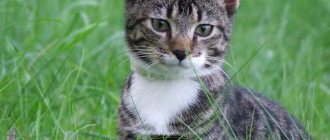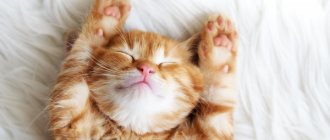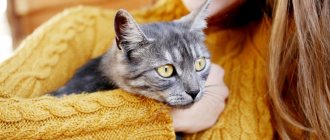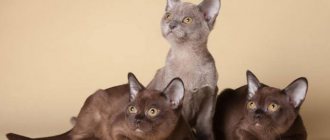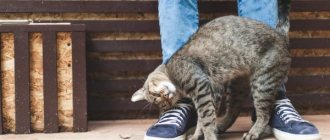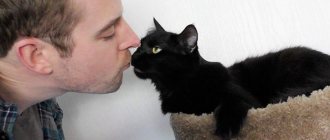4772Administration
Why know the structure of a cat's organs? Only veterinarians need detailed knowledge about this. But we know a lot about our own physiology, and in the case of standard problems and diseases we can quickly determine the cause and location of the problem. The cat cannot tell us about his problems.
The cat owner does not need to know how many bones are in the pet's skeleton. Often we don't remember such facts about our own body. Attentive owners carefully study their cat from the outside and know how many teeth it has and how its limbs are structured. But we often only learn from the veterinarian what is inside the cat and how it all works.
© shutterstock
In many ways, the organs of cats have a similar structure to the organs of other mammals. But there are also some differences.
Digestive system
The cat's digestive system consists of:
- esophagus;
- stomach;
- small intestine;
- duodenum;
- jejunum;
- liver;
- large intestine.
The esophagus has a hose-like shape of a relatively small size, and connects the animal’s mouth and its stomach. The esophagus originates from the inner base of the mouth, extends through the neck and chest, passes close to the heart, extends through the muscles of the diaphragm, and connects to the stomach. It is important to note that the esophagus is equipped with special muscles that push food into the stomach, producing synchronous movements similar to waves. The esophagus is one of the most difficult organs in terms of surgical treatment, as it is difficult to access and extremely difficult to heal.
The cat's stomach is single-chambered, and is distinguished by the location of the mucous membrane on its inner walls. The cat's stomach is adapted to accommodate a large amount of food, but it is almost never completely filled, since cats are not prone to gluttony (the vast majority). Also, the inner surface of the stomach is dotted with folds, which have an additional mechanical effect on the process of breaking down food. Food processed by gastric juice enters the duodenum through the pyloric sphincter. Most often, eaten food remains in the stomach for about 12 hours.
The small intestine is a tubular organ that connects the stomach and large intestine. Often the length of a cat's small intestine is about 1.5-2 meters, and includes the duodenum, jejunum, and ileum.
The duodenum is small in size and serves to mix food with liver and pancreatic enzymes, which is extremely important for digestion.
The jejunum is the longest part of the small intestine, and its internal walls are dotted with thin hairs, which, when in contact with food that comes into contact with them, penetrate into it and suck out all the useful substances. It is here that the final extraction of all useful substances from food occurs, after which it enters the ileum, and then the large intestine, where it turns into feces.
Respiratory system
The anatomy of a cat is not much different from other mammals. This also applies to the respiratory system. It includes the following organs :
- bronchi;
- larynx;
- lungs.
- nose;
- nasopharynx;
- trachea;
© shutterstock
The breathing process begins from the nose and nasopharynx. The nose has 2 nasal cavities inside, in which, when inhaled, the process of recognizing odors, heating the air and purifying it from impurities, dust, and debris occurs. The cavities are separated by a septum of hyaline cartilage.
The larynx is located between the trachea and pharynx, and is located above the hyoid bone. Basic functions of the larynx :
- air conduction;
- preventing food from entering the respiratory system;
- formation of sounds.
The larynx consists of five movable cartilages and a mucous membrane. It also contains the vocal cords, vocal muscle and glottis. This is where all the sounds that a cat makes are produced.
The purring of cats occurs due to the special location and functioning of the organs of the larynx. Purring occurs without effort on the part of the animal, and has the same rhythm as breathing. In this case, the muscles contract at a frequency of more than 1000 times per minute.
The vocal cords of cats differ in their structure from the vocal cords of other animals. Attentive owners may notice that the pet’s “speech” is not limited to meowing. And even ordinary meowing can be different. It is quite simple to study the “language” of your cat, and you can accurately guess what exactly the pet is telling us. For example, dogs can only make about 10 different sounds. And representatives of some cat breeds can express themselves using about 100 sounds that exist in their “lexicon”.
A healthy animal in a calm state takes about 20-25 breaths per minute. Kittens take breaths and come out more often.
Circulatory system
The circulatory system in cats works the same way as in other mammals: the heart pushes blood through arteries that have elastic walls and rhythmically carry out contraction and relaxation movements. It is thanks to such movements that arteries located close to the skin can be felt, and this is called the pulse. The cat's pulse is easiest to detect on the inside of the thigh, and in a healthy animal it should range between 100-150 beats per minute.
The cat's brain absorbs 15-20% of the blood, the muscular system absorbs up to 40% of the total blood, and about 25-30% of the blood goes to the internal organs. During physical activity, muscles can absorb up to 90% of the blood, which is why cats get tired so quickly, but can focus maximum strength for a short period of time.
Biological characteristics of cats
There are many breeds of cats: from long-haired (Persian cat) to hairless (Sphynx). A cat's skeleton consists of 230 bones, which is 24 more bones than a human's. The backbone of cats is very flexible and strong, allowing them to control their body when jumping, squeezing their body through the smallest holes where the cat's head fits. Cats have faster breathing and pulse rates than humans.
Vision in cats
A cat has the largest eyes relative to its body size. They are located on the head so that both look in the same direction, so cats have stereoscopic vision, which allows them to accurately estimate the distance to the object of observation. Cats can distinguish colors, but compared to humans, their color perception is weaker - less contrast and brighter. The cat perceives stationary and close objects worse than moving ones.
Cats see well in the dark. The light sensitivity of a cat's eye is 7 times higher than that of a human. The pupil of a cat's eye can change shape. In daylight, it is not round, like a person’s, but has a vertical oval shape. Cats have a nictitating membrane (called the third eyelid), which can be seen when the cat sleeps with its eyes slightly open or feels tired.
Hearing in cats
Cats have directional hearing, i.e. can move the auricle towards the sound source. A cat's ears move independently of each other, so the cat can listen to two sources of sound at the same time.
Taste perception in cats
Cats are very picky about food, distinguishing between sour, bitter and salty. This intelligibility is due, first of all, to a good sense of smell and developed taste buds on the tongue.
Vestibular apparatus in cats
In cats, a well-developed vestibular apparatus located in the inner ear is responsible for balance. Cats can move fearlessly along roof ridges, fences and tree branches. When falling, they can reflexively take the position in the air necessary to land on their paws.
The role of a cat in human life
Having studied the behavior of cats and their biological characteristics, scientists came to the conclusion that owners of furry pets are 30% less at risk of death from a heart attack. For pain in various areas of the human body: the cat itself identifies the sore spot, lies down on it and begins to purr.
The warmth and soothing sound calm the pain with amazing ease. It must be said that cats treat different diseases in different ways. Having found a sore spot, some lie down on it, trying to warm it up. Others, having released their claws like an acupuncturist’s needles, begin a kind of massage. As a rule, the therapeutic effect occurs at the first rumbling and purring sounds, which soothe and relax
Endocrine system
The endocrine system is primarily responsible for hormones and their production in the corresponding organs. Thus, the cat’s brain produces antidiuretic hormone, oxytocin, corticotropic hormone, adrenocorticotropic hormone, cortisol and growth hormone.
The adrenal glands produce a lot of other hormones, the main purpose of which is to regulate metabolism, and are also responsible for behavioral characteristics. The adrenal glands also produce cortisol, a small portion of testosterone, as well as epinephrine and norepinephrine.
General information
What is the anatomy of a cat's skeleton? As mentioned above, the animal’s body is divided into regions. In the head there is a face and a skull. The latter contains the anterosuperior part, the crown, the back of the head, the forehead, and the temple. The face is distinguished by the intermaxillary, buccal, orbital, oral, buccal and nasal regions. The cat's neck runs from the back of the head to the shoulder blade. The body is divided into a chest with a corresponding cavity and a back. The mammary glands are located on the chest. The back is divided into two vertebral regions. One is thoracic, the second is interscapular. In the last one on the left, in the area of the elbow joint, there is a cardiac part. The abdomen is divided into posterior, middle and anterior regions. The first contains the inguinal and pubic segments. The abdomen passes into the pelvic region. It includes the ischial, gluteal and sacral parts. The limbs of the animal are divided into pelvic and thoracic. The cat's toes have retractable claws. The animal steps on the lower part - the pads.
Nervous system
The nervous system of cats is divided into central and peripheral. Each of these systems in a cat performs functions that are standard for most mammals.
The central nervous system consists of the brain, brain stem and the so-called spinal cord. The central nervous system is the most important in the body of any living creature, and simple and complex reactions, as well as some reflexes, depend on it. In addition, the central nervous system interacts with the peripheral and autonomic ones, ensuring their functioning and control.
The peripheral nervous system is responsible for the cat's conscious motor abilities. So, thanks to this system, a cat can move its paws, extend its claws, run, and generally lead the lifestyle that it leads. Also, the peripheral nervous system transmits pain impulses to the central nervous system from any part of the body where peripheral nerve endings are present.
Integumentary tissues
The skin and fur of cats perform a protective function.
They protect the body from the penetration of infections and microorganisms, mechanical damage, ultraviolet rays, thermal and chemical influences. The top layer of skin is called the epidermis. It consists of cells and intercellular substance that firmly connects them to each other. Immediately behind it comes the basal layer, and then the dermis.
It contains nerve endings, hair follicles (hair roots and the surrounding space), sebaceous glands and small blood vessels (capillaries). There are several types of sebaceous glands.
| Location on the body | What produces |
| All over the body near the hair roots | Grease that lubricates the fur |
| In the anal area and on the paw pads | Substances with an odor that attracts individuals of the opposite sex (pheromones) |
| On the face | A substance that cats use to mark their territory. |
Separately, it is worth noting the claws, which are modified skin. Inside them are nerve endings and blood vessels.
The part of a cat's hair located above the skin consists of dead epidermal cells layered on top of each other. They reflect light, so the wool shines and shimmers in the sun.
From each follicle several hard guard hairs grow, a maximum of six. Each of them is surrounded by undercoat - soft and fine hairs. In addition, there are special muscles responsible for raising the fur on end. This muscle attaches to each follicle.
Musculoskeletal system
The cat's body has two main types of muscles: smooth muscle and striated muscle. Smooth muscles are found in all the internal organs of the cat, and are directly connected to the autonomic nervous system, thereby ensuring the work and unconscious functioning of the internal organs, an excellent example of which would be the esophagus and the heart.
The striated muscles are attached to the skeleton and provide the cat with physical strength, the ability to move, hunt and fight. The striated muscles are familiar muscles that we can feel on the limbs and body of the pet.
An important part of the musculoskeletal system of a cat are tendons, ligaments and joints, which in all cats are distinguished by strength, flexibility and enviable elasticity until old age.
The cat's shoulder girdle, which has a unique structure, deserves special mention. Thus, in almost all mammals, the bones of the forelegs are connected to the body with the help of the collarbone, but in cats, the bones of the limbs are connected to the body exclusively with the help of muscles, which provides them with incredible mobility.
Scull
It, like other bone elements, differs in some features. First of all, it is worth noting that the brain and facial parts of a cat are developed approximately equally. The first includes 11, and the second - 13 elements. The skull has a rounded shape. It has large eye sockets. There are also powerful and short jaws with very sharp teeth. The large size of the eye pits is determined by the lifestyle. Due to the size of these areas, cats can hunt successfully in low light conditions (at dawn or dusk). Powerful jaws act as the main attribute of a predatory animal. The lower part is suspended from the skull. It consists of horizontal and vertical segments. These parts break very easily when colliding with a car on the road. The size of an adult animal's skull depends on a number of factors. The size is affected by breed and gender. Individual hereditary characteristics are also important. If you look at what a cat's skeleton looks like, you can see that the bones in the skull are much larger than in the facial part. This specific feature makes the appearance of the animal unlike that of other representatives of the fauna.
Differences in the structure of cats
The internal structure of a cat differs from the structure of a cat in its reproductive system. Outwardly, this manifests itself in the fact that in cats, the scrotum is located just below the anus, while in cats, in this place there is a slit-like vagina (vulva), which can be seen in the photo.
Reproductive system
The cat's genital organs are the gonads, the testes in the scrotum, the penis and the spermatic cords, which connect to the urethra. The components of a cat's reproductive organs are the vulva, vagina, uterus and uterine tubes. Cats reach puberty at the age of 6-8 months, but this does not mean that by this moment they stop growing, just that the genitals have already formed and can be used to reproduce offspring. The endocrine glands also play an important role: the adrenal glands, the thyroid gland and the hypothalamus; they regulate many processes in the cat’s body and protect against many diseases.
Limbs
The upper regions that make up the skeleton were discussed above. A cat's front paws are different from their back paws. As mentioned above, it moves on the fingers. The heel is visible on the hind legs. It may look like it's a knee. But it is located at the level of the lower abdomen. There are five fingers on the forelimbs. At the same time, the fifth one is greatly shortened and does not touch the surface while walking. The last phalanx in each finger acts as a base for the claw. It is pulled into the pad using a special ligament. It is missing only on the first finger. It acts as a rudiment and grows separately. The claw on it does not retract. The hind limbs, unlike the forelimbs, are quite rigidly attached to the sacrum. The bones in this part are more developed and longer. The hind legs have 4 toes. Here the fifth digit, which is present on the forelimbs, is presented as a skin protrusion. The weight of the animal's body is distributed evenly over the entire foot of the hind paw. Like other mammals, the knees bend forward and the elbows bend backward. A distinctive feature of the forelimbs is also the rotating wrists.
Features of a cat's skeleton
The general structure of the cat's skeleton is similar to that of other mammals, with the exception of some differences in the shape and arrangement of individual bones, which is associated with the horizontal position of the spine and maximum adaptability to the lifestyle of a predator. In addition, differences in the shape and structure of individual bones may be due to breed characteristics. For example, Siamese have narrower and longer bones compared to Persian cats. From the photo below you can understand what a cat’s skeleton looks like without taking into account breeding characteristics.
The skeleton of a cat consists of an average of 244-250 bones. Some sources mention the figure 230-236, since some fused bones are considered as one whole. How many bones a cat has is influenced by the length of the animal's tail, since it contains almost a tenth of all the bones in a cat's body (a "normal" tail has about 26 vertebrae).

